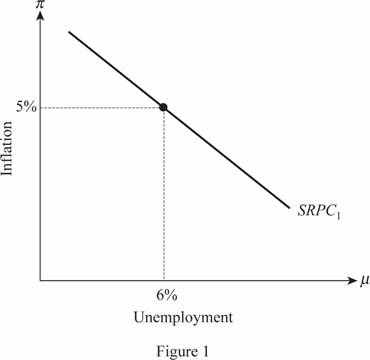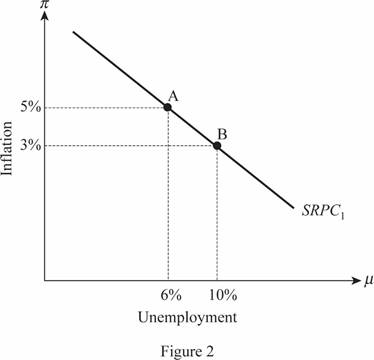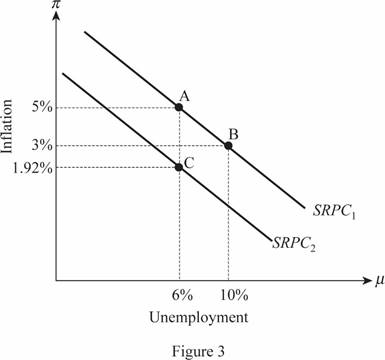
(a)
The natural rate of
(a)
Explanation of Solution
The
Here, the people make their expectations about inflation on the basis of the weighted average of the past two year's inflations. When the inflation rate is stable at 5 percent, it means that the actual inflation is same as the expected inflation and so,
Natural Rate of Unemployment: The natural rate of unemployment is the rate of unemployment that is persisting in the economy when the labor market of the economy is in its equilibrium.
(b)
The short run trade-off between the inflation and unemployment.
(b)
Explanation of Solution
The Phillips curve of the economy is given to be

Thus, the short run trade-off between the inflation which is stable at 5 percentage point and the unemployment which is at its natural rate of 6 percentage point is indicated at point A.
(c)
The impact of fall in aggregate demand short run trade-off between the inflation and unemployment.
(c)
Explanation of Solution
The Phillips curve of the economy is given to be
When the unemployment in the economy rises by 4 percentage points and becomes 10 percentage, the impact on the Phillips curve will be different because the expected inflation in the economy does not change. Thus, the Phillips curve determined the inflation rate and this can be calculated as follows:
Thus, the point B that indicates the change in the trade-off between the unemployment and inflation in the economy which will be on the same short run Phillips curve and can be illustrated as follows:

(d)
The economy during higher unemployment and after 2 years at natural rate for 10 years.
(d)
Explanation of Solution
The Phillips curve of the economy is given to be
When the unemployment in the economy rises by 4 percentage points and becomes 10 percentage, the impact on the Phillips curve will be different because the expected inflation in the economy does not change. Thus, the economy's inflation rate will be 3%. The unemployment rate, inflation rate, expected inflation rate, and the rate of output growth for the 10 years can be calculated in the following table:
| Year | Unemployment Rate | Inflation Rate | Expected Inflation Rate | Rate of Output Growth |
| 1 | 6 | 5 | 5 | 3 |
| 2 | 6 | 5 | 5 | 3 |
| 3 | 10 | 3 | 5 | −5 |
| 4 | 10 | 1.6 | 3.6 | 3 |
| 5 | 6 | 2.02 | 2.02 | 11 |
| 6 | 6 | 1.89 | 1.89 | 3 |
| 7 | 6 | 1.93 | 1.93 | 3 |
| 8 | 6 | 1.92 | 1.92 | 3 |
| 9 | 6 | 1.92 | 1.92 | 3 |
| 10 | 6 | 1.92 | 1.92 | 3 |
(e)
The impact of fall in aggregate demand short run trade-off between the inflation and unemployment.
(e)
Explanation of Solution
The Phillips curve of the economy is given to be
When the unemployment in the economy rises by 4 percentage points and becomes 10 percentage, the impact on the Phillips curve will be different because the expected inflation in the economy does not change. Thus, the Phillips curve determined the inflation rate and this can be calculated as follows:
Thus, the point B that indicates the change in the trade-off between the unemployment and inflation in the economy will be on the same short run Phillips curve. When the unemployment rate falls, the expected inflation rate would fall in the economy. This leads to the downward shift in the short run Phillips curve in the economy. From the table above, it is identified that the expected inflation rate in the economy at the end of the 10th year is 1.92 percent but the unemployment rate is 6 percent. This combination is illustrated at the point C as follows:

(f)
Before recession and after recession equilibrium.
(f)
Explanation of Solution
The Phillips curve of the economy is given to be
After recession, equilibrium is indicated at point C where the inflation rate is 1.92 and the unemployment rate is 6 percentage points. This indicates that the inflation in the economy has been decreased by 3.08 percent points in the economy. While looking at the table for the rate of growth of output, it is identified that there were a loss of 8 percent during from year 2 to year 3, whereas there were a gain of 8 percent from year 3 to year 4. From year 5 to 10, the rate of output growth remained the same which means that there is no long run sacrifice in reducing the inflation rate by the economy.
Want to see more full solutions like this?
- You are the manager of a large automobile dealership who wants to learn more about the effective- ness of various discounts offered to customers over the past 14 months. Following are the average negotiated prices for each month and the quantities sold of a basic model (adjusted for various options) over this period of time. 1. Graph this information on a scatter plot. Estimate the demand equation. What do the regression results indicate about the desirability of discounting the price? Explain. Month Price Quantity Jan. 12,500 15 Feb. 12,200 17 Mar. 11,900 16 Apr. 12,000 18 May 11,800 20 June 12,500 18 July 11,700 22 Aug. 12,100 15 Sept. 11,400 22 Oct. 11,400 25 Nov. 11,200 24 Dec. 11,000 30 Jan. 10,800 25 Feb. 10,000 28 2. What other factors besides price might be included in this equation? Do you foresee any difficulty in obtaining these additional data or incorporating them in the regression analysis?arrow_forwardsimple steps on how it should look like on excelarrow_forwardConsider options on a stock that does not pay dividends.The stock price is $100 per share, and the risk-free interest rate is 10%.Thestock moves randomly with u=1.25and d=1/u Use Excel to calculate the premium of a10-year call with a strike of $100.arrow_forward
- Please solve this, no words or explanations.arrow_forward17. Given that C=$700+0.8Y, I=$300, G=$600, what is Y if Y=C+I+G?arrow_forwardUse the Feynman technique throughout. Assume that you’re explaining the answer to someone who doesn’t know the topic at all. Write explanation in paragraphs and if you use currency use USD currency: 10. What is the mechanism or process that allows the expenditure multiplier to “work” in theKeynesian Cross Model? Explain and show both mathematically and graphically. What isthe underpinning assumption for the process to transpire?arrow_forward
- Use the Feynman technique throughout. Assume that you’reexplaining the answer to someone who doesn’t know the topic at all. Write it all in paragraphs: 2. Give an overview of the equation of exchange (EoE) as used by Classical Theory. Now,carefully explain each variable in the EoE. What is meant by the “quantity theory of money”and how is it different from or the same as the equation of exchange?arrow_forwardZbsbwhjw8272:shbwhahwh Zbsbwhjw8272:shbwhahwh Zbsbwhjw8272:shbwhahwhZbsbwhjw8272:shbwhahwhZbsbwhjw8272:shbwhahwharrow_forwardUse the Feynman technique throughout. Assume that you’re explaining the answer to someone who doesn’t know the topic at all:arrow_forward




 Macroeconomics: Private and Public Choice (MindTa...EconomicsISBN:9781305506756Author:James D. Gwartney, Richard L. Stroup, Russell S. Sobel, David A. MacphersonPublisher:Cengage Learning
Macroeconomics: Private and Public Choice (MindTa...EconomicsISBN:9781305506756Author:James D. Gwartney, Richard L. Stroup, Russell S. Sobel, David A. MacphersonPublisher:Cengage Learning Economics: Private and Public Choice (MindTap Cou...EconomicsISBN:9781305506725Author:James D. Gwartney, Richard L. Stroup, Russell S. Sobel, David A. MacphersonPublisher:Cengage Learning
Economics: Private and Public Choice (MindTap Cou...EconomicsISBN:9781305506725Author:James D. Gwartney, Richard L. Stroup, Russell S. Sobel, David A. MacphersonPublisher:Cengage Learning





